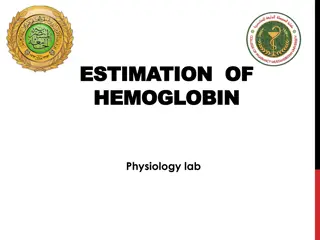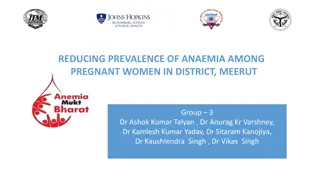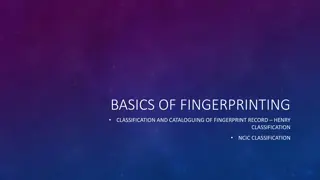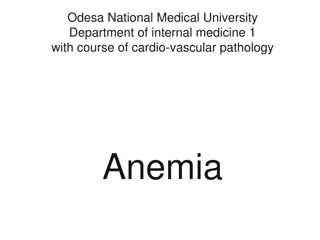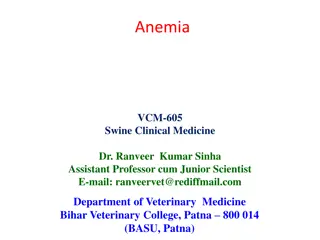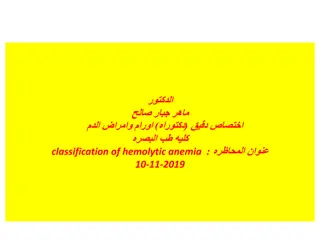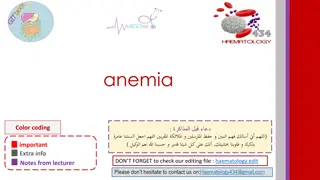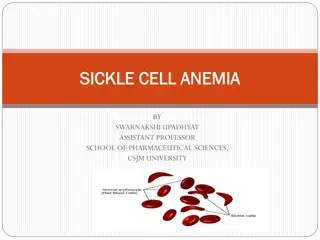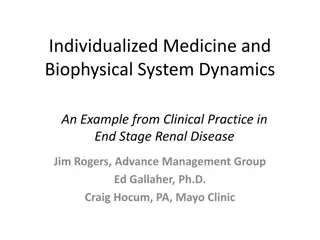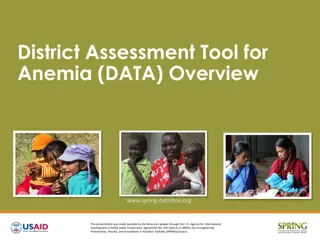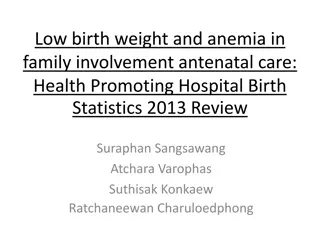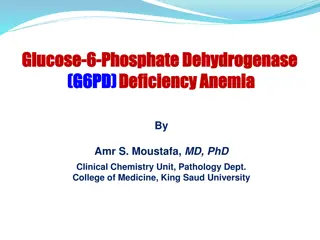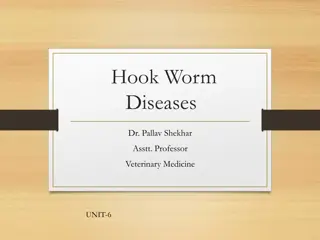Anemia: Definition, Classification, and Treatment
Anemia is a condition characterized by a deficiency in red blood cells or hemoglobin, resulting in symptoms like fatigue, breathlessness, and palpitations. This collection of images and information covers various aspects of anemia, including its classifications such as hemorrhagic, hemolytic, and aplastic anemia. It also delves into the physiological basis of treatment, iron metabolism, metabolic roles of folate and B12, hemolysis, and the fate of hemoglobin. Additionally, there are multiple-choice questions addressing Vitamin B12 deficiency and Glucose-6-phosphate dehydrogenase deficiency. Explore this resource to enhance your knowledge of blood and immunity.
Download Presentation

Please find below an Image/Link to download the presentation.
The content on the website is provided AS IS for your information and personal use only. It may not be sold, licensed, or shared on other websites without obtaining consent from the author.If you encounter any issues during the download, it is possible that the publisher has removed the file from their server.
You are allowed to download the files provided on this website for personal or commercial use, subject to the condition that they are used lawfully. All files are the property of their respective owners.
The content on the website is provided AS IS for your information and personal use only. It may not be sold, licensed, or shared on other websites without obtaining consent from the author.
E N D
Presentation Transcript
3rd lecture on blood and Immunity Anemia
Anemia Definition Classification Deficiency Anemia Hemorrhagic Hemolytic Aplastic Physiological Basis of Treatment
Misnomer Normally at rest only 25% of the oxygen carried by arterial blood is extracted by the tissues ----------- Reserve for Exercise Breathlessness, Fatigue and Palpitation G6PD deficiency Anemia RBC membrane is more prone to peroxidase damage in absence of reduced Glutathione clinical importance
Iron Metabolism Absorption Different farms At different Ages Causes Worm infestation Milk injury
Metabolic role of Folate and B12 Deoxyuridylate Required for DNA Synthesis 5,10 methylene Tetra Hydro Folic acid B12 can regenerate THFA Thymidylate
Hemolysis Corpuscular Defect Sickle cell, Thalassemia, Spherocytosis, G5PD Def Extracorpuscular Antibodies Drugs Snake venom Hypersplenism
Fate of Hb Jaundice Prehepatic Hepatic Post Hepatic Physiological Jaundice of Newborn
08.09.14 MCQ1 Vitamin B12 deficiency leads to (a)Deficiency of active farm of folate in the body (b)Deficiency of Stem cells in the Red bone marrow (c ) Both (d ) None
2 Deficiency of Glucose 6 phosphate dehydrogenase can lead to (a)Damage of RBC glutathione (b) haemolysis following consumption of some drugs like antimalarial (c) Both (d)None
3 The supplementation of only folate in Vitamin B12 deficiency will relive the symptoms but still it is not recommended in clinical practice because (a ) It can worsen neuropathic symptoms (b) It can Produce Polycythemia (c ) It can Produce Jaundice (d) It is Just a Myth it can very well be used
4 The Physiological management of Polycythemia would be (a) Venesection (phlebotomy) (b) Keeping the affected person at high altitude (c ) Some Yogasanas (d ) Dietary restrictions
5 The most common cause of Iron deficiency anaemia in an adult male in india is (a) Worm infestations (b) Nutritional (c ) Acute haemorrhages (d) Malabsorption of Iron


